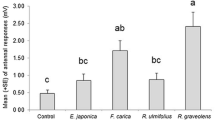Abstract
Infusions of various organic materials have been known to modify ovipositional behavior of gravid female mosquitoes. Previously, we found that an infusion of Purina Laboratory Chow elicited negative ovipositional behavior inCulex pipiens quinquefasciatus Say andCulex tarsalis Coquillett. In the present chemical studies, the Purina Laboratory Chow infusion, fermented for 10 days, was distilled to give an active distillate which, upon ether extraction, gave an active ether extract. Fractionation of the ether extract yielded an active acidic fraction and inactive nonacidic fraction. Gas Chromatographie analysis on Porapak R and AT-1200-H3PO4 columns of the acidic fraction showed the presence of acetic, propionic, isobutyric, butyric, isovaleric, and caproic acids. In bioassay tests, these lower aliphatic carboxylic acids, individually and in combination, exhibited ovipositional repellency against the two species of mosquitoes at the concentration of 6 × 10−2%. At this concentration, butyric acid caused 100% mortality in first-instar larvae ofC. p. quinquefasciatus. Gravid female mosquitoes might have acquired, through evolutional adaptation, the ability of avoiding ovipositing in unsuitable sites in which toxic compounds might be detrimental to the survival and development of their offspring.
Similar content being viewed by others
References
Acharya, C.M. 1935. Studies of the anaerobic decomposition of plant materials. 1. The anaerobic decomposition of rice straw (Oryza sativa).Biochem. J. 29:528–541.
Bentley, M.D., Mcdaniel, I.N., Lee, Y.P., Stiehl, B., andYatagai, M. 1976. Studies ofAedes triseriatus oviposition attractants produced by larvae ofAedes triseriatus andAedes atropalpus (Diptera: Culicidae).J. Med. Entomol. 13:112–115.
Brundin, A., Andersson, G., Andersson, K., Mossing, T., andKällquist, L. 1978. Short-chain aliphatic acids in the interdigital gland secretion of reindeer (Rangifer tarandus L.), and their discrimination by reindeer.J. Chem. Ecol. 4:613–622.
Dadd, R.H., andKleinjan, J.E. 1974. Autophagostimulant fromCulex pipiens larvae: Distinction from other mosquito larval factor.Environ. Entomol. 3:21–28.
Gerhardt, R.W. 1959. The influence of soil fermentation on oviposition site selection by mosquitoes.Mosq. News 19:151–155.
Gjullin, C.M., Johnson, J.O., andPlapp, T.W. 1965. The effect of odors released by various waters on the oviposition sites selected by the two species ofCulex.Mosq. News 25:268–271.
Gubler, D.J. 1971. Studies on the comparative oviposition behavior ofAedes (Stegomyia) albopictus andAedes (Stegomyia) polynesiensis Marks.J. Med. Entomol. 8:675–682.
Ikeshoji, T. 1966. Attractant and stimulant factors for oviposition ofCulex pipiens fatigans in natural breeding sites.Bull. World Health Org. 35:905–912.
Ikeshoji, T. 1968. Studies on mosquito attractants and stimulants. V. Gas-chromatographic separation of the attractants for oviposition ofCulex pipiens fatigens from the field water.Appl. Entomol. Zool. 3:176–188.
Ikeshoji, T., Saito, K., andYano, A. 1975. Bacterial production of the ovipositional attractants for mosquitoes on fatty acid substrates.Appl. Entomol. Zool. 10:239–242.
Hwang, Y.-S., Mulla, M.S., andArias, J.R. 1974. Overcrowding factors of mosquito larvae. V. Synthesis and evaluation of some branched-chain fatty acids against mosquito larvae.J. Agric. Food Chem. 22:400–403.
Hwang, Y.-S., Mulla, M.S., andAxelrod, H. 1976. Attractants for synanthropic flies. Identification of attractants and coattractants forHippelates eye gnats (Diptera: Chloropidae).J. Agric. Food Chem. 24:164–169.
Kramer, W.L., andMulla, M.S. 1979. Oviposition attractants and repellents of mosquitoes. Oviposition responses ofCulex mosquitoes to organic infusions.Envir. Entomol. 8: In press.
Michael, R.P., Keverne, E.B., andBonsall, R.W. 1971. Pheromones: Isolation of male sex attractants from a female primate.Science 172:964–966.
Michael, R.P., Bonsall, R. W., andWarner, P. 1974. Human vaginal secretion: Volatile fatty acid content.Science 186:1217–1219.
Mulla, M.S., Hwang, Y.-S., andAxelrod, H. 1977. Attractant for synanthropic flies: Chemical attractants for domestic flies.J. Econ. Entomol. 70:644–648.
Müller-Schwarze, D., Müller-Schwarze, C., Singer, A.G., andSilverstein, R.M. 1974. Mammalian pheromone: Identification of active component in the subauricular scent of the mate pronghorn.Science 183:860–862.
Soman, R.S., andReuben, R. 1970. Studies on the preference shown by ovipositing females ofAedes aegypti for water containing immature stages of the same species.J. Med. Entomol. 7:485–489.
Starratt, A.N. andOsgood, D.E. 1972. An Oviposition pheromone of the mosquitoCulex tarsalis: Diglyceride composition of the active fraction.Biochem. Biophys. Acta 280:187–193.
Author information
Authors and Affiliations
Additional information
Diptera: Culicidae.
Rights and permissions
About this article
Cite this article
Hwang, Y.S., Kramer, W.L. & Mulla, M.S. Oviposition attractants and repellents of mosquitoes. J Chem Ecol 6, 71–80 (1980). https://doi.org/10.1007/BF00987528
Received:
Revised:
Issue Date:
DOI: https://doi.org/10.1007/BF00987528




